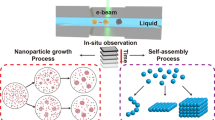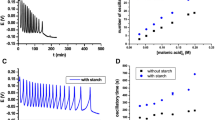Abstract
As a well-established technique, DNA synthesis offers interesting possibilities for designing multifunctional nanodevices. The micro-processing system of modern semiconductor circuits is dependent on strategies organized on silicon chips to achieve the speedy transmission of substances or information. Similarly, spatially localized structures allow for fixed DNA molecules in close proximity to each other during the synthesis of molecular circuits, thus providing a different strategy that of opening up a remarkable new area of inquiry for researchers. Herein, the Visual DSD (DNA strand displacement) modeling language was used to design and analyze the spatially organized DNA reaction network. The execution rules depend on the hybridization reaction caused by directional complementary nucleotide sequences. A series of DNA strand displacement calculations were organized on the locally coded travel track, and autonomous movement and addressing operations are gradually realized. The DNA nanodevice operates in this manner follows the embedded “molecular program”, which improves the reusability and scalability of the same sequence domain in different contexts. Through the communication between various building blocks, the DNA device-carrying the target molecule moves in a controlled manner along the programmed track. In this way, a variety of molecular functional group transport and specific partition storage can be realized. The simulation results of the visual DSD tool provide qualitative and quantitative proof for the operation of the system.
Graphical Abstract














Similar content being viewed by others
Data availability
The data used to support the findings of this study are available from the corresponding author upon request.
References
Soloveichik D, Seelig G, Winfree E (2010) DNA as a universal substrate for chemical kinetics. Proc Natl Acad Sci U S A 107(12):5393–5398. https://doi.org/10.1073/pnas.0909380107. (Epub 2010 Mar 4. PMID: 20203007; PMCID: PMC2851759)
Song X, Reif J (2019) Nucleic acid databases and molecular-scale computing. ACS Nano 13(6):6256–6268. https://doi.org/10.1021/acsnano.9b02562
Schaus TE, Woo S, Xuan F, Chen X, Yin P (2017) A DNA nanoscope via auto-cycling proximity recording. Commun 8:696. https://doi.org/10.1038/s41467-017-00542-3
Gerasimova YV, Kolpashchikov DM (2016) Towards a DNA nanoprocessor: reusable tile-integrated DNA circuits. Angew Chem Int Ed 55(35):10244–10247. https://doi.org/10.1002/anie.201603265
Chao J et al (2019) Solving mazes with single-molecule DNA navigators. Nat Mater 18(3):273–279. https://doi.org/10.1038/s41563-018-0205-3
Thubagere J, Li W, Johnson RF et al (2017) A cargo-sorting DNA robot. Science. https://doi.org/10.1126/science.aan6558
Lakin MR, Stefanovic D (2016) Supervised learning in adaptive DNA strand displacement networks. Acs Synth Biol 5(8):885–897. https://doi.org/10.1021/acssynbio.6b00009
Yurke B, Turberfifield AJ, Mills AP, Simmel FC, Neumann JL (2000) A DNA-fuelled molecular machine made of DNA. Nature 406(6796):605–608. https://doi.org/10.1038/35020524
Thubagere AJ, Thachuk C, Berleant J, Johnson RF, Ardelean DA, Cherry KM, Qian LL (2017) Compiler-aided systematic construction of large-scale DNA strand displacement circuits using unpurified components. Nat Commun 8(1):103–113. https://doi.org/10.1038/ncomms14373
Wang F, Lv H, Li Q, Li J, Zhang XL, Shi JY, Wang LH, Fan CH (2020) Implementing digital computing with DNA-based switching circuits. Nat Commun. https://doi.org/10.1038/s41467-019-13980-y
Ordóñez-Guillén NE, Martínez-Pérez IM (2019) Catalytic DNA strand displacement cascades applied to logic programming. IEEE Acces 7:100428–100441. https://doi.org/10.1109/ACCESS.2019.2928273
Qian L, Winfree E, Bruck J (2011) Neural network computation with DNA strand displacement cascades. Nature 475(7356):368–372. https://doi.org/10.1038/nature10262
Dai M, Jungmann R, Yin P (2016) Optical imaging of individual biomolecules in densely packed clusters. Nat Nanotechnol 11(9):798–807. https://doi.org/10.1038/nnano.2016.95
Song TQ, Gopalkrishnan N et al (2018) Improving the performance of DNA strand displacement circuits by shadow cancellation. ACS Nano 12(11):11689–11697. https://doi.org/10.1021/acsnano.8b07394
Dunn KE, Trefzer MA, Johnson S, Tyrrell AM (2016) Investigating the dynamics of surface-immobilized DNA nanomachines. Sci Rep 6(1):631–633. https://doi.org/10.1038/srep29581
Chatterjee G, Dalchau N, Muscat RA, Phillips A, Seelig G (2017) A spatially localized architecture for fast and modular DNA computing. Nat Nanotechnol 12(9):920–927. https://doi.org/10.1038/nnano.2017.127
Boemo MA, Lucas AE, Turberfield AJ, Cardelli L (2016) The formal language and design principles of autonomous DNA walker circuits. Acs Synth Biol 5(8):878–884. https://doi.org/10.1021/acssynbio.5b00275
Li SP, Jiang Q, Liu SL et al (2018) A DNA nanorobot functions as a cancer therapeutic in response to a molecular trigger in vivo. Nat Biotechnol 36(3):258–264. https://doi.org/10.1038/nbt.4071
Grossi G, Jepsen MDE, Kjems J, Andersen ES (2017) Control of enzyme reactions by a reconfigurable DNA nanovault. Nat Commun 8(1):65–87. https://doi.org/10.1038/s41467-017-01072-8
Kroener F, Heerwig A, Kaiser W, Mertig M, Rant U (2017) Electrical actuation of a DNA origami Nanolever on an electrode. J Am Chem Soc 139(46):16510–16513. https://doi.org/10.1021/jacs.7b10862
Zhou LF, Marras AE, Huang CM, Castro CE, Su HJ (2018) Paper origami-inspired design and actuation of DNA nanomachines with complex motions. Small. https://doi.org/10.1002/smll.201802580
Wang F, Zhang XL, Liu XG, Fan CH, Li Q (2019) Programming motions of DNA origami nanomachines. Small. https://doi.org/10.1002/smll.201900013
Kopperger E, List J, Madhira S, Rothfischer F, Lamb DC, Simmel FC (2018) A self-assembled nanoscale robotic arm controlled by electric fields. Science 359(6373):296–300. https://doi.org/10.1126/science.aao4284
Hagiya M, Konagaya A, Kobayashi S, Saito H, Murata S (2014) Molecular robots with sensors and intelligence. Acc Chem Res 47(6):1681–1690. https://doi.org/10.1021/ar400318d
Aubert N, Mosca C, Fujii T, Hagiya M, Rondelez Y (2014) Computer-assisted design for scaling up systems based on DNA reaction networks. J R Soc Interface. https://doi.org/10.1098/rsif.2013.1167
Lakin MR, Youssef S, Cardelli L, Phillips A (2012) Abstractions for DNA circuit design. J R Soc Interface 9(68):470–486. https://doi.org/10.1098/rsif.2011.0343
Petersen RL, Lakin MR, Phillips A (2016) A strand graph semantics for DNA-based computation. Theor Comput Sci 632:43–73. https://doi.org/10.1016/j.tcs.2015.07.041
Lakin MR, Phillips A (2017) Automated, constraint-based analysis of tethered DNA nanostructures. In: 23rd International Conference on DNA computing and molecular programming, pp 1–16, https://doi.org/10.1007/978-3-319-66799-7_1
Zhang DY, Turberfield AJ, Yurke B, Winfree E (2007) Engineering entropy-driven reactions and networks catalyzed by DNA. Science 318(5853):1121–1125. https://doi.org/10.1126/science.1148532
Bath J, Green SJ, Turberfield AJ (2005) A free-running DNA motor powered by a nicking enzyme. Angew Chem 44(48):4358–4361. https://doi.org/10.1002/anie.200501262
Acknowledgements
This research This work was supported by National Natural Science Foundation of China (no. 62073207), Natural Science Basic Research Plan in Shaanxi Province of China (no. 2020JM-298). The authors are very grateful to the anonymous reviewers for their valuable comments and suggestions for improving the quality of the paper.
Author information
Authors and Affiliations
Corresponding author
Ethics declarations
Conflict of interest
The authors declare that they have no competing interests.
Supplementary Information
Below is the link to the electronic supplementary material.
Rights and permissions
Springer Nature or its licensor (e.g. a society or other partner) holds exclusive rights to this article under a publishing agreement with the author(s) or other rightsholder(s); author self-archiving of the accepted manuscript version of this article is solely governed by the terms of such publishing agreement and applicable law.
About this article
Cite this article
Wang, Y., Wang, L., Hu, W. et al. Design and Simulation of an Autonomous Molecular Mechanism Using Spatially Localized DNA Computation. Interdiscip Sci Comput Life Sci 15, 1–14 (2023). https://doi.org/10.1007/s12539-023-00551-5
Received:
Revised:
Accepted:
Published:
Issue Date:
DOI: https://doi.org/10.1007/s12539-023-00551-5




